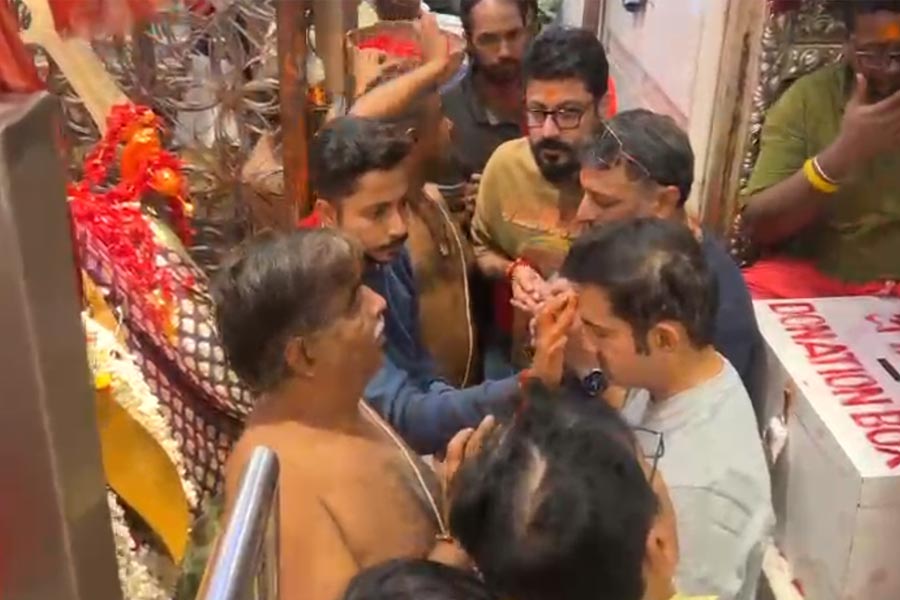Now everyone says libraries are dead. But we have proved it wrong,” says Bipul Chakraborty, librarian of Adhyayan Sammilani Pathagar, a library in Betor, Howrah. He does not have to do much to substantiate the claims about the library that is turning 100 this week.
I am visiting it on a hot April afternoon that has left me exhausted. Not that the library interior offers any respite from the heat — it is spacious but has no air-conditioning. Yet, at 3 in the afternoon, it is filling up. “We have seven members signed in already,” says Chakraborty. Some sit and read at the library, newspapers and magazines, others borrow books.
The temperature has failed to affect the mood at the library, which is festive, as the members and the librarian are caught up in organising the centennial celebrations, to start on April 14.
A flurry of activity fills the library. The cupboards are being reorganised. The library building, a compact two-level structure that houses 8,000 books, has been painted over, but not with just a coat of paint. With artist Soumitra Kar, a resident of the area, at the helm, students and young people from around have painted portraits of writers and thin-kers — Jibanananda Das, Ashapurna Devi, Narayan Debnath among them — that look at us from the front wall.
One arresting portrait is of S.R. Ranganathan, a pioneer of library science in India. Below are painted (in Bengali) “The five laws of library science” that he formulated. 1. Books are for use. 2. Every reader (will have) his/her book. 3. Every book (will have) its reader. 4. Save the time of the reader. 5. The library is a growing organism.
Below the portrait of Bankimchandra Chattopadhyay are the words: “Bengalis need their history to be written...”
Adhyayan Sammilani Pathagar has about 800 members. The librarian and the members hold one another responsible for the effort and enthusiasm that sustain the library. Several members are present that day: Soumitra Kar, Partha Kar, Shubha Basu, one of the most senior members, Tumpa Das and secretary Ardhendu Lahiri.
Basu, whose mother-in-law was known for burning whatever was cooking on the stove as she remained lost in her reading, says she has never seen a librarian like Chakraborty. The librarian, who has been posted here as an employee of the state government library service, says he has not come across a neighbourhood that supports a library in such a way.
The institution is sustained also by its past. “Betor is a very old place,” says Soumitra. It was a busy port and trading centre, where European merchants would come. The Hooghly river ran through the area and so did the Saraswati.
For the centennial year, Partha has written a brief history of Betor. Cesare Federici, a Venetian explorer, mentions visiting Betor around 1578, he says. The place also finds mention in a 15th-century Manasamangal by Biprodas Pipilai, adds Partha. It is said that Chand Sadagar, the merchant in Manasamangal who angers Manasa, the serpent goddess, had stopped here on his way to the high seas.
With the Hooghly moving away, the port disappeared, and so did the Saraswati. There is almost no trace of Betor’s prosperous past. But pride in it remained.
By the dawning of the British era, the locality transformed into a residential area. The Saraswati was reduced to a canal to disappear permanently later. The left wall of the library has been painted with an evocative but imaginary scene of the Saraswati.
The neighbourhood set up a library in 1924 called Tarun Pratishthan, where Adhyayan Sammilani Pathagar stands today. It was primarily for under- privileged children. But
nationalist feelings ran high and the neighbourhood was known to give shelter to revolutionaries. Team members of Surya Sen, who would conduct the Chattagram Arms Robbery, would hide here, says Partha.
To escape the raids, the old library was reinvented and given a new name. Adhyayan Sammilani Pathagar was established on Poila Baisakh, Bengali New Year’s Day, on April 14, 1925. One wonders if any other institution could have continued this way. Books have a special ability to survive.
The new library was founded under the leadership of scholar Shashtri Narendranath Ganguly. It has in its holdings every kind of book. Popular fiction is a large category. Basu, like many members, was hooked to novels, of Ashutosh Mukherjee, among others. Now she prefers short stories.
The library has a collection of old and new biographies, travelogues, poetry, drama which are now being dusted and rediscovered.
Another member, Amlan Mukhopadhyay, comes in with hand-painted signs for the prabhat pheri or morning procession. He has painted the texts on the walls outside and is now fixing the old wooden cupboards. Scholar Shekhar Mukhopadhyay is organising the “rare” books, which will be made available for reading.
The library runs on contributions. It offers tuition for competitive exams, free of cost, for the neighbourhood youth. It hosts literary events, too. It hopes to invite writers and cultural personalities from Howrah, such as Nalini Bera, to be part of its centenary celebrations. “No one can do this alone,” says librarian Chakraborty.
Chakraborty mentions an incident. Two labourers had been hired to repair a cupboard. He had paid them Rs 400. One of them came back, and very hesitantly, returned Rs 200.
It was his contribution towards the library.











